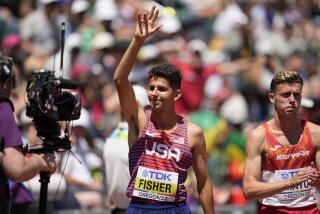CYCLING : Biathlete King Hopes a Fast Finish Will Make Up for Her Late Start
- Share via
Karrie King of Northridge has raced in only one of the four races in this summer’s Coors Lite biathlon series.
She missed the first three run-bike-run competitions because of a stress fracture in her right leg. But after a sixth-place effort in the series stop in Columbus, Ohio, on Sunday, King is tied for 10th place with 16 points overall.
Points are awarded on a 50-40-32-26-20-16-13-10-8-7 basis throughout the 14-race series. In the Grand Prix finale in November, point totals are doubled.
“I’m going to try to do enough races so I can get a lot of points (to qualify for the Grand Prix),” said King, who needs four more points for entry into the field.
The Grand Prix has a $50,000 purse, said King, who is in her second year of professional racing. Prize money is awarded to the first five finishers in the men’s and women’s divisions.
As a tuneup for the national-scale CLBS, King finished fourth in the National Biathlon Championships’ pro division on July 15 in Ontario.
King, 20, a 1988 graduate of Granada Hills High, is the youngest woman competitor on the pro circuit. Liz Downing of Portland, Ore., the top-ranked woman biathlete in the nation, is 31.
“I’m the youngest, but nobody says much,” King said. “I’m always introduced as ‘up-and-coming’ or ‘the new kid on the block.’ ”
King’s next CLBS race is Aug. 5 in San Francisco.
Trivia time: Who was the first U. S. cyclist to win an Olympic medal? (Hint: He was a road racer).
Put your pedal to the metal: The differences between a track bike and a road bike aren’t always apparent, but they are always very real--as many novice riders are painfully aware.
Although some track bikes look similar to road bikes, riders moving from the road to the velodrome often find themselves sprawled out on the track simply because they stopped pedaling.
Unlike road bikes, track bikes have a locked rear hub, which means that the rider must continue to pedal and allow the friction of the tires against the track to slow the bike. Track bikes also do not have brakes.
Rick Denmen, the race director at Encino Velodrome, conducts riding classes at the track and frequently has witnessed the confusion this causes.
“I had a class for UCLA students and I had a rider who tried coasting after he finished the race,” Denmen said. “He came very close to launching himself.”
Denmen recalled a 1988 incident at Encino Velodrome involving an intermediate rider, Mark Flath, who “definitely ended up with some broken bones.”
Flath, Denmen said, swerved to the top of a banked curve at the velodrome and stopped pedaling momentarily. “It just slipped his mind a little bit and he went for a tumble.”
Track-racing classes for novice to advanced riders are held weekly at the velodrome. Novice riding classes are conducted on Saturdays at 8 a.m. and advanced classes are Mondays at 7 p.m. All sessions are two hours long.
Information: 818-881-7441.
Trivia answer: Carl Schutte won a bronze medal in the 1912 Games in Stockholm. He timed 10 hours 52 minutes 38.8 seconds over the 320-kilometer course, the longest road race in Olympic history.


